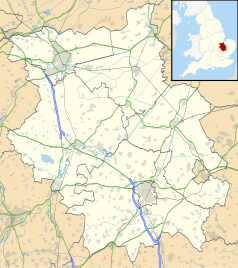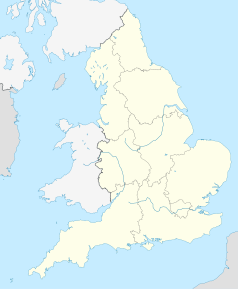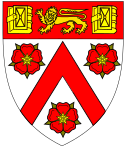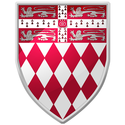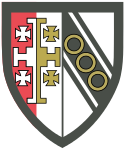St Catharine’s College (Cambridge)
| ||
| University of Cambridge | ||
 | ||
(c) Robin Drayton, CC BY-SA 2.0 Brama Główna | ||
| Data założenia | 1473 | |
| Typ | kolegium uniwersyteckie | |
| Patron | św. Katarzyna Aleksandryjska | |
| Państwo | ||
| Adres | St Catharine’s College Cambridge CB2 1RL | |
| Liczba studentów | 636 (2015-16)[1] | |
| Mistrz | Mark Welland | |
Położenie na mapie Cambridgeshire Contains Ordnance Survey data © Crown copyright and database right, CC BY-SA 3.0 | ||
Położenie na mapie Wielkiej Brytanii (c) Karte: NordNordWest, Lizenz: Creative Commons by-sa-3.0 de | ||
| Strona internetowa | ||
St Catharine’s – jedno z kolegiów (ang. colleges) Uniwersytetu w Cambridge w Anglii, ufundowane w roku 1473.
Podobnie jak wszystkie pozostałe 30 kolegiów, St Catharine’s jest niezależną, samorządną instytucją, dysponującą własnym majątkiem i samodzielnie pozyskującą fundusze oraz prowadzącą nabór studentów.
Pełna, oficjalna nazwa Kolegium to: Kolegium albo Aula Świętej Katarzyny Dziewicy w Uniwersytecie Cambridge (The College or Hall of Saint Catharine the Virgin in the University of Cambridge). Nazwa potoczna to Cats[2].
Historia
Założycielem St Catharine’s College był Robert Woodlark, rektor (Provost) King’s College. Powstanie Kolegium, noszącego początkowo (do roku 1860) nazwę St Catharine’s Hall, ogłoszono w dniu patronki, św. Katarzyny Aleksandryjskiej - 25 listopada 1473 roku. Fundacja Kolegium została potwierdzona aktem króla Edwarda IV z roku 1475. Zgodnie z życzeniem fundatora pierwotną formą Kolegium była niewielka społeczność duchownych, których zadaniem była modlitwa za jego duszę oraz kształcenie się w dziedzinie filozofii i teologii[a]. Tak nakreślone cele istnienia Kolegium oznaczały, iż początkowo przyjmowało ono jedynie studentów wyższych poziomów studiów pomijając kształcenie na poziomie licencjackim. Dopiero trudności finansowe, jakie dosięgły Kolegium w okresie Reformacji, zmusiły je do rozszerzenia naboru o studentów początkowych lat studiów.
XVII wiek, po roku 1626, był dla Kolegium okresem rozwoju zakłóconym jedynie usunięciem z Uniwersytetu jego rektora i wszystkich członków w trakcie angielskiej wojny domowej. W tym czasie przyjmowano rocznie 20-30 nowych studentów[3]. W latach 1673-1704 miała miejsce duża przebudowa, która nadała jego zabudowaniom obecny kształt.
W roku 1861 konflikt o stanowisko rektora St Catharine’s (tzw. Robinson Vote) doprowadził do zapaści Kolegium trwającej aż do wybuchu I wojny światowej. Reputacja Kolegium podupadła tak bardzo, że około roku 1880 pojawił się nawet postulat jego połączenia z King’s College[4]. Otaczająca St Catharine’s zła sława powodowała spadek napływu i poziomu nowych studentów.
Współczesność
Kolegium przyjmuje studentów na wszystkie kierunki dostępne na Uniwersytecie z wyjątkiem architektury, pedagogiki, filologii obcych i historii sztuki. Studenci przyjmowani są niezależnie od kraju pochodzenia. W roku akademickim 2015-16 w St Catharine’s studiowało 472 studentów studiów licencjackich, 48 – magisterskich i 116 – doktoranckich[1].
Według rankingu Tompkins Table szeregującego kolegia Uniwersytetu w Cambridge według wyników uzyskiwanych od roku 1997 na egzaminach przez ich członków będących studentami studiów licencjackich, St Catharine’s zajęło w 2016 roku 17. miejsce - 24,6% jego studentów uzyskało najwyższe noty (Firsts)[5]. Najwyższą – 1. – pozycję Kolegium zajęło w roku 2005, a średnia zajmowana pozycja to 10,4.
Roczne koszta utrzymania Kolegium wyniosły w roku akademickim 2015-16 10,945 mln £. Wartość należących do St Catharine’s inwestycji - nieruchomości i papierów wartościowych - wynosiła w tymże roku 104,847 mln £[6].
St Catharine’s jest znane ze szczególnie silnych tradycji muzycznych. W jego obrębie istnieją między innymi dwa chóry, w tym pierwszy w Wielkiej Brytanii kolegialny chór żeński[7].
Kolegium siostrzanym dla St Catharine’s w Uniwersytecie Oksfordzkim jest Worcester College.
Budynki
Kolegium zajmuje teren w centrum Cambridge w sąsiedztwie najstarszych kolegiów Uniwersytetu. Zabudowany jedynie z trzech stron główny dziedziniec St Catharine’s otwarty jest na ulicę Trumpington Street, od której oddziela go płot i brama. Pierwotne zabudowania Kolegium zostały rozebrane na początku XVII wieku.
Budynek Hobson’s Building (od strony Trumpington Street, na prawo od bramy) zajmuje częściowo miejsce, w którym znajdowały się stajnie należące do Thomasa Hobsona (1544-1631), właściciela firmy zapewniającej konne połączenie między Cambridge a Londynem. Hobson trzymał się zasady, że wypożyczyć można tylko tego konia, który stoi najdłużej w stajni skąd wzięło się angielskie określenie Hobson's choice (pol. wybór Hobsona) oznaczające pozorną możliwość wyboru[8].
Herb i święta patronka Kolegium
Herb St Catharine’s przedstawia na czerwonym polu złote koło tortur o ośmiu szprychach, z ostrzami na obwodzie. Według tradycji św. Katarzyna miała zostać skazana na śmierć przez łamanie kołem.
Srebrna pieczęć Kolegium, którą prawdopodobnie posługiwał się osobiście jego fundator[3], przedstawia klęczącą św. Katarzynę z kołem na plecach.
Uwagi
- ↑ J.P.C Roach et al., 1959: Woodlark w spisanym własnoręcznie statucie Kolegium wykluczył kształcenie w dziedzinach prawa i medycyny.
Przypisy
- ↑ a b Facts and Figures 2017 ↓.
- ↑ Stubbings 1995 ↓, s. 23.
- ↑ a b J.P.C. Roach et. al. 1959 ↓.
- ↑ Jones 2010 ↓, s. 150.
- ↑ Varsity 2016 ↓.
- ↑ Financial Statements 2016 ↓.
- ↑ Music ↓.
- ↑ Stubbings 1995 ↓, s. 63.
Bibliografia
- Harry Curtis: The Tompkins Table 2016: Christ’s has risen (ang.). Varsity, 2016-10-29. [dostęp 2016-11-17].
- About the University: Facts and Figures 2017 (ang.). University of Cambridge, 2017. [dostęp 2017-07-16].
- Financial Statements for the Year Ended 30 June 2016 (ang.). St Catharine’s College, Cambridge. [dostęp 2017-07-23].
- William Henry Samuel Jones: A History of St Catharine's College, Cambridge: Once Catharine Hall, Cambridge. Cambridge University Press, 2010, seria: Cambridge Library Collection. ISBN 978-1-108-00896-9. (ang.)
- Music (ang.). W: About St Catharine’s College [on-line]. St Catharine’s College, Cambridge. [dostęp 2017-07-23].
- Frank Stubbings: Bedders, Bulldogs and Bedells: A Cambridge Glossary. Cambridge University Press, 1995. ISBN 978-0-521-47978-3. (ang.)
- The colleges and halls: St Catharine's. W: A History of the County of Cambridge and the Isle of Ely: Volume 3, the City and University of Cambridge. J.P.C. Roach (red.). 1959, s. 415-420, seria: Victoria County History. [dostęp 2017-07-23]. (ang.)
| ||||
Media użyte na tej stronie
(c) Karte: NordNordWest, Lizenz: Creative Commons by-sa-3.0 de
Location map of the United Kingdom
Autor: made by User:Akjz, Licencja: CC-BY-SA-3.0
Shield of Churchill College, Cambridge.
(c) Sebastian Ballard, CC BY-SA 2.0
St Catharine's College
Autor: Rama, Licencja: CC BY-SA 2.0 fr
Arms of Magdalene College, Cambridge
Autor: w:User:Lupin, Licencja: CC-BY-SA-3.0
Description at en.wiki: made by me in Inkscape. Additional description by User:JackyR: Shield of Clare Hall, Cambridge.
Autor:
Made by Lupin using Inkscape and licensed under GFDL. Recropped by Richie.
EDIT: corrected symmetries and minor errors. --F l a n k e r 13:49, 14 March 2007 (UTC), Licencja: CC-BY-SA-3.0Crest of Pembroke College, Cambridge.
Autor: Homerton College, Licencja: CC BY-SA 4.0
The Coat of Arms of Homerton College, displayed upon a shield.
Autor: w:User:Lupin, Licencja: CC-BY-SA-3.0
Description at en.wiki: made by me in Inkscape. Additional description by User:JackyR: Shield of Lucy Cavendish College, Cambridge.
Autor: Wikimandia, Licencja: CC BY-SA 4.0
Arms of Girton College, Cambridge. Based on examples [1] and at https://www.girton.cam.ac.uk/.
Autor: made by User:Akjz, Licencja: CC-BY-SA-3.0
Shield of Wolfson College, Cambridge.
Autor: Originally uploaded to the English Wikipedia by en:User:Sakurambo., Licencja: CC BY 2.5
The coat of arms of Downing College, Cambridge.
Blazon: Barry of eight argent and vert, a griffin segreant or (for Downing) within a bordure azure charged with eight roses of the first seeded and barbed proper.Autor: Ta ^specifik^ z W3C grafika wektorowa została stworzona za pomocą Inkscape ., Licencja: CC BY-SA 3.0
The shield of King's College, Cambridge, as often depicted with Rose details not in the Blazon.
Autor: Recropped by Richie., Licencja: CC-BY-SA-3.0
Arms of Queens' College, Cambridge.
Cambridge University coat of arms, granted for use by the Chancellor, Masters, Fellows and Scholars as a corporate body. The blazon is composed of: "Gules, a cross ermine between four lions passant guardant or, and on the cross a closed book fessways gules clasped and garnished gold, the clasps downward".
The original blazon read: "Gules sur ung croix dermines entre quatre Lions passant d'or Livre de gules".[1]
Autor: K. Aainsqatsi, Licencja: CC-BY-SA-3.0
St Catharine's College Crest
Contains Ordnance Survey data © Crown copyright and database right, CC BY-SA 3.0
Map of Cambridgeshire, UK with the following information shown:
- Administrative borders
- Coastline, lakes and rivers
- Roads and railways
- Urban areas
Equirectangular map projection on WGS 84 datum, with N/S stretched 160%
Geographic limits:
- West: 0.53W
- East: 0.55E
- North: 52.75N
- South: 51.99N
Autor: Lupin, Licencja: CC-BY-SA-3.0
The shield of Christ's College, Cambridge, being the arms of the foundress Lady Margaret Beaufort.
(c) Hughesstudent at the English Wikipedia, CC-BY-SA-3.0
Shield of Hughes Hall, Cambridge
Autor: Selkie upsilon, Licencja: CC BY-SA 3.0
Crest of Murray Edwards College, Cambridge.
Royal Charter as received by New Hall in 1972: Sable a Dolphin palewise head downwards to the dexter in chief three Mullets fesswise a Bordure embattled Argent
Made by Selkie_upsilon using Inkscape.Autor: ACB Smith, Licencja: CC BY-SA 4.0
* Author: ACB Smith
- My own work, a rework of the previous version based on bindings in the college library and the description of the armorial binding. Made using Illustrator CS5.
- Description of the Armorial Bearing: "Argent, on a chevron between 2 couple closes indented sable 3 escallops or impaling, or, semee of flowers gentle, in the middle of the chief a sengrene resting upon the heads of 2 serpents in pale, their tails knit together, all proper, resting upon a square marble stone vert, between their breasts a book sable garnished gules, buckles or; all within a bordure compony argent and sable"
Autor: Richie, Licencja: CC-BY-SA-3.0
Crest of Trinity College, Cambridge.
Autor: Recropped by Richie., Licencja: CC-BY-SA-3.0
Crest of Sidney Sussex College, Cambridge.
Autor: User:Lupin, Licencja: CC-BY-SA-3.0
Description:Crest of St. John's Collge, Cambridge
The crest of Robinson College, Cambridge
Autor: Lupin, Recropped by Richie., Licencja: CC-BY-SA-3.0
Crest of Peterhouse, Cambridge: Four pales gules a border gules charged with golden crowns
Autor: made by User:Akjz, Licencja: CC-BY-SA-3.0
Arms of Bateman, as used by William Bateman (d.1355), Bishop of Norwich 1344-55, founder of Trinity Hall, Cambridge: Sable, a crescent ermine a bordure engrailed of the last. As seen at Trinity Hall, Cambridge (over B staircase), impaled by the arms of the See of Norwich. See image[1]
Autor: made by User:Akjz, Licencja: CC-BY-SA-3.0
Shield of St Edmund's College, Cambridge.
Autor: A1 Aardvark, Licencja: CC BY-SA 3.0
Coat of arms of en:Darwin College, Cambridge.
Autor: Lupin, Recropped by Richie., Licencja: CC-BY-SA-3.0
Coat of arms of Jesus College, Cambridge. Canting arms of John Alcock (c. 1430 – 1500), Bishop of Ely and founder of Jesus College, Cambridge: Argent, a fesse sable between three cock's heads erased sable crested and jelloped gules a bordure of the last charged with eight ducal coronets or
(c) Robin Drayton, CC BY-SA 2.0
St Catharine's College Viewed from Trumpington Street.
Autor: Zenobia Homan, Licencja: CC BY-SA 3.0
Crest of Fitzwilliam College, Cambridge. Made in Photoshop CS6.
Autor: w:User:Lupin, Licencja: CC-BY-SA-3.0
Description at en.wiki: made by me in Inkscape. Additional description : Shield of Newnham College, Cambridge.
Autor: Recropped by Richie., Licencja: CC-BY-SA-3.0
Crest of Selwyn College, Cambridge (Arms of See of Lichfield impaling Selwyn, arms of Bishop Selwyn).

